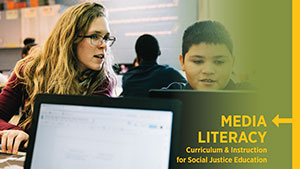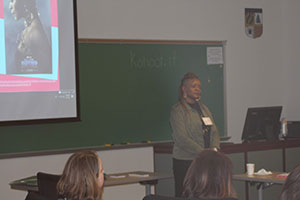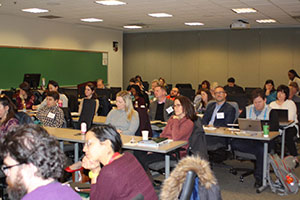Media Literacy Curriculum and Instruction for Social Justice Education

Loyola University Maryland's School of Education curriculum and instruction for social justice Master’s program, along with co-host, The National Association for Media Literacy Education (NAMLE), hosted its first annual Media Literacy Curriculum and Instruction for Social Justice Professional Development Conference at Loyola University Maryland’s Timonium Graduate Center. This exciting, meaningful, and thought-provoking day was focused on helping K-12 teachers teach their students to “access, analyze, evaluate, create, and act” using all forms of media communications, from music to video to social media, for the purpose of social justice.
 The conference featured a wide range of presenters who covered a variety of topics
including curriculum and instruction related to teaching the film Black Panther, media
coverage of the 2016 presidential election, and utilizing social media to enhance
literacy and student activism. The conference also included two keynote addresses,
first from the vice president for Newseum Education, Barbara McCormack, who discussed
the importance of the First Amendment, and from the executive director of NAMLE, Michelle
Ciulla Lipkin, who discussed the ways that NAMLE provides teachers with resources
for teaching media literacy for social justice.
The conference featured a wide range of presenters who covered a variety of topics
including curriculum and instruction related to teaching the film Black Panther, media
coverage of the 2016 presidential election, and utilizing social media to enhance
literacy and student activism. The conference also included two keynote addresses,
first from the vice president for Newseum Education, Barbara McCormack, who discussed
the importance of the First Amendment, and from the executive director of NAMLE, Michelle
Ciulla Lipkin, who discussed the ways that NAMLE provides teachers with resources
for teaching media literacy for social justice.
Throughout the day, teachers were given time to collaborate, ask questions, and receive practical ideas for implementing a variety of media into their existing curriculum with the purpose of engaging and empowering their students. The day was a huge success, full of energy and enthusiasm.
 As a teacher who has an interest in integrating media into my classroom in engaging,
innovative, and effective ways, I walked away from the conference with several ideas,
lessons, and strategies that I will be able to incorporate immediately. I especially
enjoyed the conference’s focus on utilizing media to engage students in social justice;
at a time when media is often being used to divide society. I appreciated the focus
on how to use media to make a positive impact and make students more aware of the
ways that they can become involved members of a democracy. However, I didn’t just
walk away from the conference with practical skills and ideas for lessons—perhaps
more importantly—I left feeling energized by the incredible conversations and collaboration
I had with a range of educators throughout the day. It didn’t matter that we taught
different subjects or grade levels or demographics of students, we all had a passion
for the content, and I was inspired by them to break out of my comfort zone and try
something new and innovative.
As a teacher who has an interest in integrating media into my classroom in engaging,
innovative, and effective ways, I walked away from the conference with several ideas,
lessons, and strategies that I will be able to incorporate immediately. I especially
enjoyed the conference’s focus on utilizing media to engage students in social justice;
at a time when media is often being used to divide society. I appreciated the focus
on how to use media to make a positive impact and make students more aware of the
ways that they can become involved members of a democracy. However, I didn’t just
walk away from the conference with practical skills and ideas for lessons—perhaps
more importantly—I left feeling energized by the incredible conversations and collaboration
I had with a range of educators throughout the day. It didn’t matter that we taught
different subjects or grade levels or demographics of students, we all had a passion
for the content, and I was inspired by them to break out of my comfort zone and try
something new and innovative.
Written by Hilary Frank, curriculum and instruction for social justice advisory board member, a 2013 curriculum and instruction for social justice alumna, and middle school English language arts teacher, Glenwood Middle School, Howard County Public Schools.